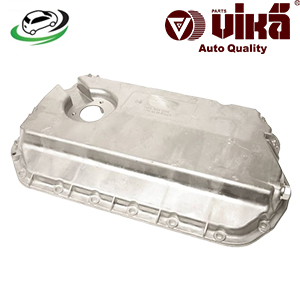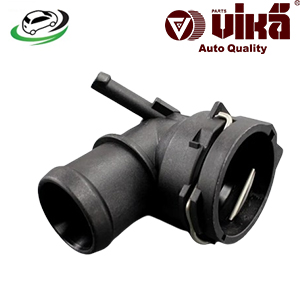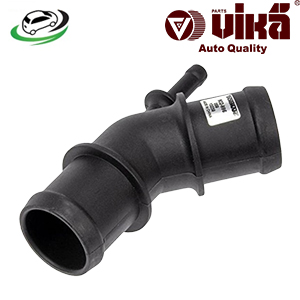Get Coolant Distribution Pipe Audi A3 8P/ B6 S4/ TT MKII / VW EOS/ Golf IV/ CC/ Jetta IV/ Passat B6/ Passat B7/ R32 MKV 1J0121087B
The coolant distribution pipe is a critical component in a vehicle’s cooling system, essential for maintaining optimal engine temperature and ensuring reliable performance. It plays a vital role in directing coolant flow to various engine components, thereby preventing overheating and sustaining engine efficiency. This overview will delve into the coolant distribution pipe’s functions, design, materials, common issues, and maintenance.
Benefits of Coolant Distribution Pipe
1. Efficient Coolant Distribution
The primary benefit of a coolant distribution pipe is its role in efficiently distributing coolant throughout the engine. By directing coolant to various engine components, it helps maintain an even temperature across the engine. This prevents localized overheating, which can cause engine damage and inefficiencies.
2. Prevention of Overheating
One of the most critical benefits is preventing engine overheating. By ensuring that coolant reaches all necessary parts of the engine, the distribution pipe helps avoid excessive heat buildup. Overheating can lead to severe engine damage, such as warping, cracking, or even complete engine failure. The coolant distribution pipe helps mitigate this risk by maintaining a stable operating temperature.
3. Enhanced Engine Performance
Maintaining optimal engine temperature is crucial for engine performance. An engine that operates within its designed temperature range performs better, with improved fuel combustion, power output, and efficiency. The coolant distribution pipe ensures that the engine remains at this optimal temperature, enhancing overall performance.
4. Improved Fuel Efficiency
Engines that operate at the correct temperature burn fuel more efficiently. By preventing overheating and maintaining consistent temperatures, the coolant distribution pipe contributes to better fuel efficiency. This can lead to cost savings on fuel and reduced emissions, making the vehicle more environmentally friendly.
5. Extended Engine Life
Consistent and proper cooling helps extend the life of engine components. Overheating can cause premature wear and tear on engine parts, leading to more frequent repairs or replacements. The coolant distribution pipe helps protect these components by ensuring that they remain within their optimal temperature range, thereby extending their lifespan.
6. Reduced Risk of Engine Damage
The coolant distribution pipe helps prevent engine damage caused by overheating. By ensuring that coolant is evenly distributed and effectively cooling all parts of the engine, it reduces the risk of thermal stress and damage to critical components such as the cylinder heads, pistons, and gaskets.
7. Smooth Operation of Engine Components
The engine cooling system relies on proper coolant flow to function smoothly. The coolant distribution pipe helps ensure that all parts of the engine receive the necessary cooling. This promotes smooth operation and reduces the likelihood of issues such as engine knocking or irregular performance.
8. Reduced Maintenance Costs
By preventing overheating and engine damage, the coolant distribution pipe can help reduce overall maintenance costs. Regular maintenance and prompt repair or replacement of the pipe can prevent more significant issues and costly repairs down the line.
9. Prevention of Coolant Leaks
A well-functioning coolant distribution pipe, along with its seals and gaskets, helps prevent coolant leaks. Leaks can lead to a loss of coolant, reduced cooling efficiency, and potential engine overheating. By maintaining a sealed and intact distribution system, the pipe helps prevent these issues.
10. Enhanced Safety
Proper engine cooling is crucial for vehicle safety. Overheating can lead to sudden engine failures, which can be dangerous while driving. By ensuring that the engine remains within safe operating temperatures, the coolant distribution pipe contributes to overall vehicle safety.
Design and Construction
- Materials: Coolant distribution pipes are typically made from materials that can withstand high temperatures and resist corrosion. Common materials include:
- Aluminum: Lightweight and resistant to corrosion, aluminum is often used in high-performance applications.
- Steel: Provides strength and durability, often used in heavy-duty vehicles.
- Plastic: Used in modern vehicles for its lightweight and cost-effective properties, but typically reinforced to handle the stress and heat.
- Shape and Routing: The design of the coolant distribution pipe varies depending on the engine layout and vehicle model. It typically includes several bends and junctions to route the coolant effectively. The shape must accommodate the engine’s specific layout while ensuring efficient coolant flow.
- Seals and Gaskets: To prevent leaks, the coolant distribution pipe is equipped with seals and gaskets at various junctions. These components are crucial for maintaining a tight seal and preventing coolant loss.
Common Issues
- Leaks: Over time, seals and gaskets can degrade, leading to coolant leaks. Leaks can result in coolant loss, reducing cooling efficiency and potentially leading to overheating. Visible signs of leaks include coolant puddles under the vehicle or a decrease in coolant levels.
- Cracks and Corrosion: Exposure to high temperatures and harsh engine environments can cause the coolant distribution pipe to crack or corrode. Corrosion is especially common in metal pipes and can lead to structural weaknesses and leaks.
- Blockages: Debris or sediment can sometimes clog the coolant distribution pipe, restricting coolant flow and reducing cooling efficiency. Blockages can lead to uneven cooling and overheating of engine components.
- Wear and Tear: Regular engine vibrations and thermal cycling can cause wear and tear on the coolant distribution pipe. Over time, this can lead to deterioration and failure of the component.
Replacement and Repair
- Replacement: If the coolant distribution pipe is severely damaged or corroded, replacement is often the best option. When replacing the pipe, ensure that the new part is compatible with your vehicle’s make and model. Follow manufacturer recommendations for installation to ensure proper fit and function.
- Repair: Minor leaks or cracks may sometimes be repaired using specialized sealants or patches. However, repair is generally a temporary solution, and replacement is usually recommended for long-term reliability.
- DIY vs. Professional Help: For those with automotive experience, replacing or repairing the coolant distribution pipe might be a feasible DIY project. However, for most vehicle owners, seeking professional assistance ensures proper installation and avoids potential issues.
Follow us on Facebook for more parts.



